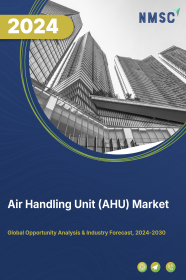
Air Handling Unit (AHU) Market by Type (Packaged, Modular, and Custom), by Installation (Rooftop and Indoor), by Capacity ( less than or equal to 5,000 M3/H, 5,001 – 15,000 M3/H, 15,001 – 30,000 M3/H, 30,001 – 50,000 M3/H, and greater than or equal to 50,001 M3/H), and by Application (Commercial, Industrial, and Residential) – Global Opportunity Analysis and Industry Forecast, 2024–2030
Industry: Construction & Manufacturing | Publish Date: 07-Mar-2024 | No of Pages: 264 | No. of Tables: 200 | No. of Figures: 171 | Format: PDF | Report Code : N/A
Market Definition
The global Air Handling Unit (AHU) Market size was valued at USD 12.47 billion in 2023, and is predicted to reach USD 18.47 billion by 2030, with a CAGR of 5.2% from 2024 to 2030.
The air handling unit (AHU), also known as air handler, is a fundamental component in heating, ventilation, and air conditioning (HVAC) systems, facilitating efficient airflow regulation and indoor climate control across commercial, industrial, and residential sectors. It collects air from the outside and inside, removes dust and other particles from the collected air, adjusts temperature and humidity, and then supplies clean and conditioned air in the room through ducts.
Rapid urbanization, infrastructure development, and rise in awareness toward energy efficiency and indoor air quality propels the market growth. Major players such as Daikin Industries, Johnson Controls International PLC, Trane Technologies, and Carrier Global Corporation dominate the global market, offering a wide array of solutions ranging from standard AHUs to customized energy-efficient units.
Increasing Demand for HVAC Systems Fuel the Market Growth
The rise in demand for HVAC systems serves as a significant driver for market growth. As urbanization accelerates and infrastructure development burgeons globally, the need for efficient heating, ventilation, and air conditioning solutions has become paramount.
This rise in demand from various sectors, including commercial, residential, healthcare, and industrial, for HVAC systems to ensure optimal indoor comfort and air quality further peoples the market growth. According to Next Move Strategy Consulting (NMSC), the global HVAC industry was valued at USD 209.4 billion in 2023 and is estimated to reach USD 332.2 billion by 2030, with a CAGR of 6.3% from 2024–2030.
In addition, stringent regulations and standards set by the World Health Organization (WHO), International Organization for Standardization (ISO), and European Union (EU) on indoor air quality and energy efficiency further propel the market growth. Moreover, an increase in awareness among consumers regarding the importance of maintaining a healthy indoor environment drives the adoption of these systems.
Rising Construction Activities Boost the AHU Industry
Growth in construction activities is expected to propel the AHU market growth. With urbanization, there is a rise in infrastructure development globally, which in turn has led to a rise in demand for efficient HVAC systems. There is a high demand for reliable HVAC solutions across residential, commercial, industrial, and institutional sectors, and AHUs play a pivotal role in these systems, which propels the market growth.
According to the McKinsey Global Institute (MGI), the construction sector is one of the largest in the world economy, with around USD 10 trillion spent on construction-related goods and services every year.
Moreover, as sustainability becomes a focal point in construction practices, AHU manufacturers are increasingly incorporating energy-efficient designs and technologies to meet green building standards and regulatory requirements.
This alignment with sustainable practices further augments the demand for AHUs in construction projects. Moreover, the AHU industry is positioned for substantial growth as construction activities continue to expand, presenting abundant opportunities for AHU manufacturers to cater to the evolving needs of the construction market.
High Cost of Raw Materials Hinders the Market Growth
A key restraint for the air handler industry is its reliance on raw materials and components from third-party suppliers. This dependency, coupled with concentrated purchasing practices, leaves manufacturers vulnerable to supply disruptions and cost increases. Factors such as disruptions at supplier facilities, rise in material costs, and climate change-related challenges further aggravate supply chain constraints.
These issues can lead to production delays, increased costs, and potential adverse impacts on business operations and profitability. Hence, the industry faces significant challenges in managing supply chain complexities and risks, which can affect operational efficiency and competitive positioning. These factors further restrain the market growth.
Integration of IoT in AUHs Creates New Opportunities
Integration of Internet of Things (IoT) technology within air handling units (AHUs) and HVAC systems propels the market growth. IoT enables AHUs and HVAC systems to be connected to the internet, allowing data collection, cloud storage, improved operations, and predictive maintenance scheduling.
This connectivity also facilitates remote monitoring, control, and diagnosis of AHUs and HVAC systems, leading to cost-effective maintenance and repair. By providing access to real-time performance data, IoT-enabled buildings can alert facility managers of operational abnormalities, potentially minimizing system failures and reducing energy consumption. Hence, integration of IoT in these units is expected to increase opportunities for the market growth by enhancing their efficiency.
Asia-Pacific Dominates AHU Industry, With the Highest Projected CAGR of 6.4% till 2030
Asia-Pacific presents substantial growth opportunities for the air handling unit market, owing to factors such as rapid urbanization, increase in infrastructure development, and growth in emphasis on energy efficiency and sustainability.
According to the UN-Habitat, urbanization remains a key megatrend in the Asia-Pacific region, with over 2.2 billion people, constituting 54% of the global urban population, residing in this region. Projections indicate a 50% increase in the region's urban population by 2050, adding 1.2 billion people.
Moreover, the dominance of China in the global air conditioner market, producing around 70% of the world's room air conditioners and accounting for 22% of the installed cooling capacity globally, directly drives the demand for air handlers to support these systems, as reported by the International Energy Agency (IEA).
In addition, the increasing global demand for air conditioning drives growth in AHU demand from leading Japanese companies such as Daikin Industries, Ltd. Addressing carbon neutrality challenges, Daikin develops energy-efficient products and establishes a new production base in Tsukubamirai City, Ibaraki Prefecture, to enhance domestic production efficiency and meet market demands.
Japan's pivotal role as a hub enables AHU manufacturers to expand globally, with projecting a tripling of global air conditioning demand by 2050, offering significant business prospects for Daikin Industries, the world's largest air conditioning company.
Competitive Landscape
Various market players operating in the AHU industry include Daikin Industries, Ltd., Carrier Global Corporation, Trane Technologies, Midea Group, Johnson Controls, Lennox International, Stulz GmbH, Rheem Manufacturing Company, SINKO INDUSTRIES LTD., Systemair AB, and others. These market players are adopting strategies such as business expansion, product launches, and acquisition across various regions to maintain their dominance in the air handler market.
For instance, in January 2024, Carrier expanded its HVAC product portfolio in India with a range of AHUs and fan coil units (FCUs) tailored for diverse commercial building needs, emphasizing high-efficiency air filtering for healthy indoor environments.
Moreover, in November 2023, Daikin introduced kits to connect air handling units with DX outdoor units, offering a packaged solution for simplified supply and compatibility with R-32 or R-410A coils, ensuring low carbon heating, cooling, and fresh air solutions for commercial spaces.
In addition, in October 2023, Lennox acquired AES to expand its commercial HVAC services (including AHU) across North America. The acquisition is expected to provide new offerings for customers and support the growth strategy of Lennox's Commercial Heating and Cooling Business segment.
Furthermore, in March 2023, Rheem launched the Endeavor Line featuring gas furnaces, air handlers, and air conditioning/heat pump units, equipped with EcoNet technology for remote control via smart thermostats or connected devices, along with Bluetooth connectivity.
Air Handling Unit (AHU) Market Key Segments
By Type
-
Packaged
-
Modular
-
Custom
By Installation
-
Rooftop
-
Indoor
By Capacity
-
≤ 5,000 M3/H
-
5,001 – 15,000 M3/H
-
15,001 – 30,000 M3/H
-
30,001 – 50,000 M3/H
-
≥ 50,001 M3/H
By Application
-
Commercial
-
Industrial
-
Residential
By Region
-
North America
-
The U.S.
-
Canada
-
Mexico
-
-
Europe
-
The UK
-
Germany
-
France
-
Italy
-
Spain
-
Denmark
-
Netherlands
-
Finland
-
Sweden
-
Norway
-
Russia
-
Rest of Europe
-
-
Asia-Pacific
-
China
-
Japan
-
India
-
South Korea
-
Australia
-
Indonesia
-
Singapore
-
Taiwan
-
Thailand
-
Rest of Asia-Pacific
-
-
Rest of the World (RoW)
-
Latin America
-
Middle East
-
Africa
-
REPORT SCOPE AND SEGMENTATION:
|
Parameters |
Details |
|
Market Size in 2023 |
USD 12.47 Billion |
|
Revenue Forecast in 2030 |
USD 18.47 Billion |
|
Growth Rate |
CAGR of 5.2% from 2024 to 2030 |
|
Analysis Period |
2023–2030 |
|
Base Year Considered |
2023 |
|
Forecast Period |
2024–2030 |
|
Market Size Estimation |
Billion (USD) |
|
Growth Factors |
|
|
Countries Covered |
28 |
|
Companies Profiled |
10 |
|
Market Share |
Available for 10 companies |
|
Customization Scope |
Free customization (equivalent to up to 80 working hours of analysts) after purchase. Addition or alteration to country, regional, and segment scope. |
|
Pricing and Purchase Options |
Avail customized purchase options to meet your exact research needs. |
KEY PLAYERS
-
Daikin Industries, Ltd.
-
Carrier Global Corporation
-
Trane Technologies
-
Midea Group
-
Johnson Controls
-
Lennox International
-
Stulz GmbH
-
Rheem Manufacturing Company
-
SINKO INDUSTRIES LTD.
-
Systemair AB

















 Speak to Our Analyst
Speak to Our Analyst





















